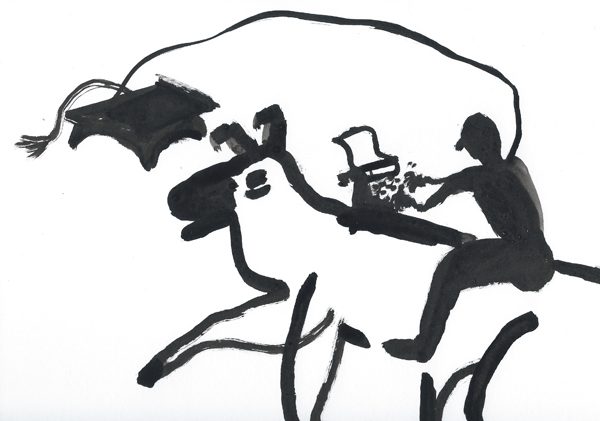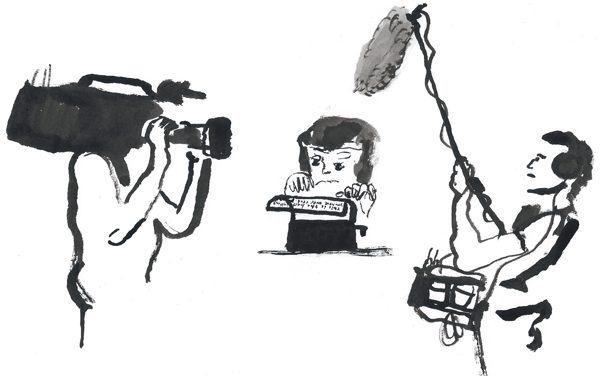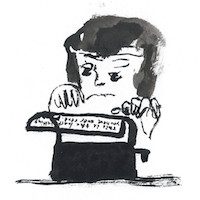If you’re a writer, you’ve likely talked about an MFA in Creative Writing at some point. You’ve considered, longed for, applied for, been rejected by, scoffed at, or at least said the words Iowa Writer’s Workshop. I’m one of those who’ve wanted to attend a program since 2006, when I graduated from undergrad with a major in creative writing.
That year, I bought Tom Kealey’s The MFA Handbook, and spent nights crawling through his blog, imagining my life somewhere other than in that room on that street in San Pablo, lying on the floor so the glow from my computer would not attract undue attention, so I wouldn’t get caught by any stray bullets. Not that there were constant gunfights on Brookside Drive, but there were shots here and there, and I was young and somewhat sheltered. I consumed Tom’s blog as I consumed catalogues of courses when I was in high school, highlighting the classes I would want to take at each school, making a timeline of application milestones—only this time, my start year could be any year.
Later on, a friend recommended Robin Tung’s website, Affording the MFA. Both Tom and Robin struck me as strong advocates for the prospective MFA student and I wondered why. What was their motivation to help people along in this process? Why even pursue an MFA at all?
In March, I began a conversation with Tom and Robin to answer those questions, among others.
***
The Rumpus: Why do most people want MFAs? In the handbook, Tom urges people to pursue it as one of many options to give themselves the time to be a writer for a while. Did you go into your own programs with that intention?
Tom Kealey: I think I’ll go way back in time and try to remember why I wanted an MFA. It’s true that in some ways I wanted to change my life. I wanted to move to a different place and start again. And at the same time there was this very clear voice that was telling me: “If you don’t make writing your #1 focus, it’s going to remain as the #7 or #8 focus.” Going to an MFA program (University of Massachusetts Amherst) helped me prioritize writing in a way that I couldn’t have on my own.
And again, I am talking about myself. I am in no way saying that all or even most or many writers need an MFA program. If you want to be a writer, write. As much as you can.
An MFA in Creative Writing is an artistic degree. Just like a master’s degree in sculpture or dance. While it qualifies you to do many things professionally, it is primarily about the craft. It is not a post-graduate job guarantee by any means.
Robin Tung: The MFA allows a writer to carve out two or three years solely for writing. It’s a sort of protected space where a writer can develop and experiment with the craft while receiving insight from faculty or advisors. It also provides great support through the literary community that exists within or around the program.
I applied to MFA programs for two main reasons: I wanted uninterrupted time to write, and I knew that there were things I didn’t know or understand about the craft at my age and stage of practice. I really valued the fact that there would be seasoned writers who could teach writing as an art. In the process, I also had the opportunity get training as a lecturer and editorial assistant, and met some brilliant writers who have become lifelong friends.
Rumpus: It occurs to me that you have become somewhat of a team of therapists for the prospective MFA student. A lot of your work is in demystifying the application experience and calming the anxiety that comes with picking schools and crossing one’s fingers—though I imagine that’s still built into the process. Perhaps now it’s just more of an informed finger crossing?
Kealey: I like that. An informed finger crossing. I wish that Seth Abramson were here to join his voice with ours. He has done so much on behalf of MFA students (and programs, for that matter), and he would have the relevant statistics. But it’s my sense that the acceptance rates for programs is anywhere between 3-15%. I’m sort of glad that I didn’t know that when I first applied.
Demystifying seems like the right word also. Going back to the law school example: If you graduated with a ____ GPA, and scored _____ on your LSAT, and went to _______ for undergraduate, then you basically know already which grad school you can get into. In the MFA world, the main focus of the application is on the writing sample (and having that writing sample match up with the right graduate program readers). Part of it is finger crossing, yes, but it’s our wish to point out which part is ‘luck’ and which parts we can control for. And then to encourage students to focus on those parts (writing sample, school selection, personal statement) that they can control for.
 Tung: That’s a great way of describing it: mystical. I think that once you’re actually in the program, and talking with professors, and learning (or overhearing) about the admissions process, things become concrete, and less mysterious. But there are definitely some tangible steps a writer can take to at least ensure an organized—and hopefully successful—application process. One of my biggest pieces of advice to writers is to start early. That way you won’t have to cross your fingers when you send out the manuscript, which, I believe, accounts for 90+% of admissions.
Tung: That’s a great way of describing it: mystical. I think that once you’re actually in the program, and talking with professors, and learning (or overhearing) about the admissions process, things become concrete, and less mysterious. But there are definitely some tangible steps a writer can take to at least ensure an organized—and hopefully successful—application process. One of my biggest pieces of advice to writers is to start early. That way you won’t have to cross your fingers when you send out the manuscript, which, I believe, accounts for 90+% of admissions.
Rumpus: How perfect does a writing sample need to be? Are programs looking for potential or polish?
Kealey: It has to be completely perfect.
Okay, just kidding. It does, though, have to be the strongest work that the student has written up to that point. Prospective applicants should place most of their efforts into writing as many good stories, poems, or novel chapters as they can (in the months leading up to the applications). Then, they should seek feedback from friends who are either writers or who are particularly enthusiastic literary fiction readers. Then, writers simply send in the best sample that they have produced to that point.
By simple, I mean it actually is simple, though not necessarily easy. Read a lot; write a lot. Edit well. Get feedback. Finish the writing sample and send it in. In this way, potential students are not only focusing on the most important element of the application, they are actually using the application process to improve as a writer.
Tung: From the mini-interviews I’ve conducted with MFA faculty on Affording the MFA, the manuscript needs to have heart, and be representative of who a writer is. There has to be an emotional undercurrent running throughout the piece. If you as the writer don’t feel anything for the story, the reader won’t either. The story has to have a pulse. Admissions faculty will be able to see through a piece that’s simply belletristic, and style or wit without substance is boring.
Programs are definitely looking for potential. (Of course, this also means that your sample should be carefully proofread and edited.) Potential stems from the substance of the writing sample, and not merely style. Readers will be considering not only what is being written about, but also how it is perceived and told through the writing.
Kealey: I couldn’t agree more with what Robin just said. I don’t know which writer said it, but he/she said, “I don’t know what voice is, but I know when it is absent.” And that voice can’t be absent in the writing sample. It has to be there. That said, write as much as you can, and turn in your best work.
Tung: Tom is exactly right. It’s very much about voice and perspective. You can imagine that admissions faculty will be reading a hundred stories about a couple breaking up, and you’ve likely read a hundred stories in magazines and books about that, too. What makes a story exciting is the voice and the perspective—what is noticed, and how and why things happen.
Rumpus: Why do people apply to as many as 12 schools? It’s hard for me to imagine someone genuinely wanting to attend each of 12 schools. But maybe I’m picky.
Kealey: It’s a good point, Ryan. On some level, I don’t think it’s healthy to say, “I’m only going to go if I get into Iowa, NYU, or Virginia” (for example). Although, if that’s how a student truly feels, then okay. But I know for me: I wanted to go to a school that would fund me, that was in the Northeast or Pacific Northwest, whose students gave it enthusiastic recommendations, and where I would gain teaching experience. That opened up a lot of possibilities.
Actually, I know how to answer this question: I only applied to five schools (because no one had advised me otherwise, and there was no Rumpus back then). When I got rejected from the first three and wait listed to the fourth, man… and I mean, man oh man… I wish I’d applied to more.
Tung: That’s a tough decision. I think it’s good to be picky. This question is actually about priorities. If you get into your 12th school—and let’s assume you applied to fully-funded programs—and have fully prepared to invest the next couple years for writing, then by all means, do it. But if you have a terrible gut feeling about the relocation/program, then reapply the following year.
Rumpus: Can you break down the components of an application? What does the application actually consist of?
Tung: All programs will require a manuscript, personal statement, application, and three letters of recommendation. The manuscript will consist of 10-15 single-spaced pages of poetry or 20-40 double-spaced pages of fiction (usually of no more than 2-3 stories or a novel excerpt). The manuscript carries the most weight of these elements. The personal statement should be professional and exhibit facility with language, and a clear understanding of who you are, where you come from, what you want, and how you’re going to accomplish it at the particular MFA program. Tone and organization are key in the statement.
Often my students and clients worry about the recommendation letters. Many writers may have been out of school for some time, or only have work-related recommenders, etc. In the end I’ve found that you can definitely succeed with work-related recommenders if they can speak to your professionalism, collegiality, work ethic, and contributions. So it’s more important to find someone who really knows you rather than someone who is a writer and doesn’t know you well.
Rumpus: It seems like it would take a long time to prepare all of that, especially if you’re working full time. Do people tend to go on MFA application lockdown (every night and weekend) for a year while getting their applications together?
Kealey: MFA lockdown. I like it. That could be a new reality show. Robin and I could come over to Ryan’s house for the first episode. My overall answer is that the first application takes the longest.  After that, each additional application takes only the time it takes to refocus the personal statement, and to complete the application itself. Of course, each application costs money too. I’d say an average of $70 per application. So, students will have to budget for that.
After that, each additional application takes only the time it takes to refocus the personal statement, and to complete the application itself. Of course, each application costs money too. I’d say an average of $70 per application. So, students will have to budget for that.
Tung: Locked in with Tom and Robin. We need to make a fake trailer.
And, yes, that sounds right. It will cost about $1,000 to apply to a dozen schools. However, schools also offer waivers for those under a certain income, and so that’s something to consider.
Kealey: As far as a time budget goes: Starting by the late spring prior to the application deadlines (generally from December-February) is really helpful for the GREs and especially for the writing sample. Write, write, write. And of course, giving your recommenders time to write their letters is essential too.
You know, I’d love to hear from Rumpus readers, particularly MFAs and former MFAs, about the time it took to complete their applications. But overall I’d say that yes, it is a part-time job. 5-10 hours a week, not including writing time.
Tung: I tell students and clients to start as early as possible. I push for late spring for starting the writing sample so that writers have some options in terms of what to submit, and plenty of time to really work on a story or set of poems. Starting early also allows writers to step away from the work for a couple weeks at a time, and to really assess what they’re doing, how they’re doing it, and whether there are better ways of telling a story or crafting poems. And that way, it’s not an insane adrenaline- and caffeine-fueled race to the finish. Creativity requires some amount of relaxation and meditation; you can’t always force things to work within the constraint of a month or so.
Rumpus: Could you suggest any particular links or sources for prospective students to visit, as they begin this process?
Tung: I highly recommend Tom’s MFA Blog and also the group MFA Draft ‘15 on Facebook. I like sources that are interactive, where writers/applicants can post their concerns, solutions, and answers, and see what other people are thinking and going through, too. I have to admit that I don’t keep up with many MFA articles. I like to go straight to the source.
Kealey: The MFA Blog is useful, but I don’t update it as much as I used to. It can be searched though, for sure. And I totally agree about the MFA Draft group. Definitely, definitely, definitely get the Sept./Oct. Poets & Writers issue, which is always focused on MFAs. You can buy a back issue, or get it online. Also, one link that I like so much is Elizabeth McCracken’s MFA tweets. She offers some tremendous (and brief) insights from an MFA faculty regarding applications.
Rumpus: Thank you both for sharing your knowledge. I think this may be my spring to start, so it’s exciting!
Tung: Yes, get writing!
Kealey: Yes, get writing, or Robin and I will show up at your house.
***
Rumpus original art by Liam Golden.
***
Tom Kealey’s short story collection Thieves I’ve Known won the Flannery O’Connor Award, and was released in September 2013. He teaches creative writing at Stanford University. More at TOM-KEALEY.COM.
Robin Tung earned her MFA from The Johns Hopkins University, and her writings appear in Black Warrior Review, The Labletter, The Montreal Review, NANO Fiction, Per Contra, Sugar House Review, This Recording, and Valparaiso Poetry Review among others. Her services for writers can be found at www.robintung.com.





6 responses
5-10 hours a week, not including writing time?! Doing what exactly?
Good Question. 5-10 hours per week = researching programs, studying for the GRE, downloading and filling out the application forms, interviewing MFA students for advice, writing the cover letters, searching online for advice, setting up Letters of Recommendation perhaps on Interfolio.com, copy-editing final manuscripts, corresponding with Recommenders, more.
I’m all for spending more time at the beach and less on MFA applications. That said, setting aside time week by week is a good strategy. It’s either a marathon or half-marathon, not a 5k.
Thanks for this incredibly resourceful and helpful interview, Ryan, Tom, and Robin!
What’s the single most important thing you learned during your MFA that you don’t think you would’ve learned elsewhere?
Thanks for this…so applies to other MFA disciplines as well. I got my MFA in dance and it has changed my life in many ways – very worthwhile!
Great interview! Tom and Robin: I’m wondering if you can speak more about the value of the relationships you built through your MFA programs? I’m considering applying for a few programs, and that may be one of my biggest motivations, to become a part of a community of writers. How many of your cohorts and teachers have you maintained contact with since completing your programs?
Chengos, great question! What I learned in my program and what I continue to learn is written well on the Writing Seminars’ (Johns Hopkins) website: “the discipline of writing that is intended to establish habits and skills necessary to lead the life of a writer.” The discipline is what sustains the lifelong practice of writing.
Click here to subscribe today and leave your comment.